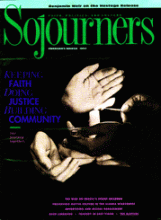SAO PAULO, BRAZIL--The Praca de Se, Sao Paulo's public square, swarms with vendors, gypsies, evangelist preachers, and commuters at all hours of the day and night. It is alive with the electric buzz of the city. But it is also the scene of violent attacks on street children by members of the military police and their undercover, off-duty cronies.
Elilda dos Santos, a leader in the Pastoral Ministry for Youth run by the Catholic Church, walks the Praca each night, making her rounds in the center of Sao Paulo. A young woman in her 30s, Elilda has been protecting children here since 1985, gaining their trust, coming face to face with their murderers, and with the politicians and judges who quietly stand aside and allow the killing to go on.
"When I started this work in 1985, we had a problem with kids in the streets, but the situation was different. In July 1990, the Secretary for Youth in the state of Sao Paulo announced that 'We are going to provide services for all these children, so that we will have no more children on the streets.'
"That sounds like a noble pronouncement; but after that, the justiceiros, as the exterminators are called, declared an all-out war on our kids. They come into an area and shoot an entire group of five, seven, or 10 without cause," Elilda told me.
A recent report by the Federal University of Rio de Janeiro asserts that between 1988 and 1990, 4,611 children from 5 to 17 years of age were killed in Brazil. The majority of these were in the states of Sao Paulo, Rio, Pernambuco, and Bahia.
Read the Full Article

